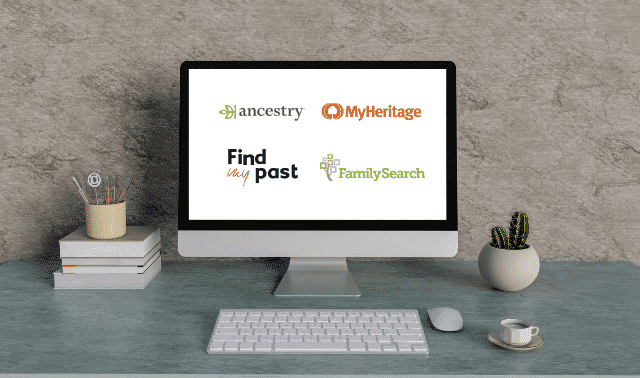Sign up for the Family Tree Newsletter Plus, you’ll receive our 10 Essential Genealogy Research Forms PDF as a special thank you!
Get Your Free Genealogy Forms
"*" indicates required fields
Whether you have been exploring your family tree for years or just begun your genealogy journey, you likely understand the joy that comes with making progress with your research project. That said, as you get deeper into any genealogy projects, you might run into obstacles—and sometimes the solution may sit behind a hefty paywall. Or maybe you want to start a new project altogether, but it requires some costly tools and resources to pull off. Below are some tips to help you craft a genealogy budget that suits your needs while still allowing you to make remarkable discoveries about your ancestors.
1. Write Down Your Current Everyday Expenses and Needs
The truth is that everyday life can be expensive, before you even factor in hobbies like genealogy projects. If you don’t already keep a list of your expenses and the amount of money you allocate to each one, you might consider adopting that habit as you budget for your genealogy research. That way, you can ensure that you can comfortably meet your needs while also giving yourself room to splurge on your genealogy project. Start by simply taking note of the things you need daily, weekly and monthly to live: food, medicine, toiletries and so on.
You can find many free helpful budgeting tools online to help you outline your expenses. For example, Nerd Wallet offers a handy budget tool that you can customize to meet your needs (i.e., whether you are currently working or retired). This tool allows you to account for both your wants and your needs.
ADVERTISEMENT
2. Consider Your Current Goals and What You Need to Complete Them
Before you start shopping around for the fanciest preservation materials and signing up for every subscription site, you will want to take a moment to consider what your goals are. You might even want to write up a genealogy research plan to ensure that your goals are tangible, clear and realistic to you. A good genealogy research plan usually always begins with a clear objective. Once you have drafted your plan, make a list of the supplies and tools you will need to complete your goals.
For example, if you want to learn everything you can about your father’s side of the family and are currently working with limited information, you can expect to have to do some extensive research. You may even have to hunt down records that can’t be found via a quick Google search. You might then decide that paying for an Ancestry subscription is worth the money in the long term (more information on that below).
3. Take Inventory of What You Already Have
If you spend any time adding up the costs of major subscription services, fees for ordering certain records and even basic preservation materials, you might experience some sticker shock. But don’t rush to buy everything all at once; take a step back and consider the materials, records and resources you have at your disposal right now—think obituaries and birth notices clipped from old newspapers, thoughtfully framed photos of Great Grandma and so on.
ADVERTISEMENT
All that said, depending on the number of materials in your possession, managing them all can be challenging. Consider writing a list of what you have so that you don’t have to worry about ending up with duplicate records you don’t need. You could also make use of our Free Personal Records Inventory Form to ensure that all records are accounted for.
4. Compare Prices on Supplies and Tools
Whether you are seeking out archival supplies to preserve important documents and cherished photos or researching the best genealogy subscription site to fit your research needs, you will want to consider all of your options before making any purchases.
Fortunately, this process need not be too challenging. For physical products like archival supplies, you can start by searching your favorite vendors for the supplies you need. For example, if you want a newspaper preservation kit so that you can safely keep crucial newspaper clippings, you might start by looking to a few reliable sellers: Gaylord Archival, Archival Methods and even just Amazon. First, of course, you will look at the prices. However, remember that you aren’t just looking to buy the cheapest materials but also the most suitable for the job. As such, you will also want to read the descriptions of each product carefully.
To aid your comparison, you could make a spreadsheet that compares each product according to a few key features: price, brand, unique features any special discounts or offers and so on.

For subscription sites, you could follow a similar process of comparison. That said, subscription sites also often offer one advantage that tangible genealogy supplies do not: free trials that allow you get a feel for the features before you commit financially. With that in mind, you could try all “major” genealogy websites via the free trial (Ancestry, MyHeritage and FindMyPast) and then factor in your experience with each when you make your final decision. The best part is that FamilySearch (one of the “Big Four” websites) is free—you might get everything you need from it and not need to spring for a paid subscription with anyone else.
5. Give Yourself a Realistic Timeline
Above all else, remember that very, very few genealogy projects have strict deadlines. If you add up the costs of the required supplies and resources and realize that it would be too expensive to purchase everything at once, you could break down your project into manageable chunks—by month or several months or even entire years. There is no ideal timeline, only what is right for you. You might even set aside a bit of money for genealogy projects every month and allow yourself to use that and no more for any materials you need.
What this strategy looks like will of course depend upon the scope of your project. For example, if you aim to organize all of your important documents but don’t have the funds to spare on newspaper preservation kits, photo preservation materials and more, you might begin by dedicating two months to sorting out the newspapers alone. In the first month, you could buy the materials you need while in the second month you focus on organizing every article, obituary and clippings to your liking. This approach can not only help you budget strategically, it can also ensure that you don’t become too overwhelmed by trying to tackle too much at once.
Last updated, January 2024.
Related Reads
ADVERTISEMENT










